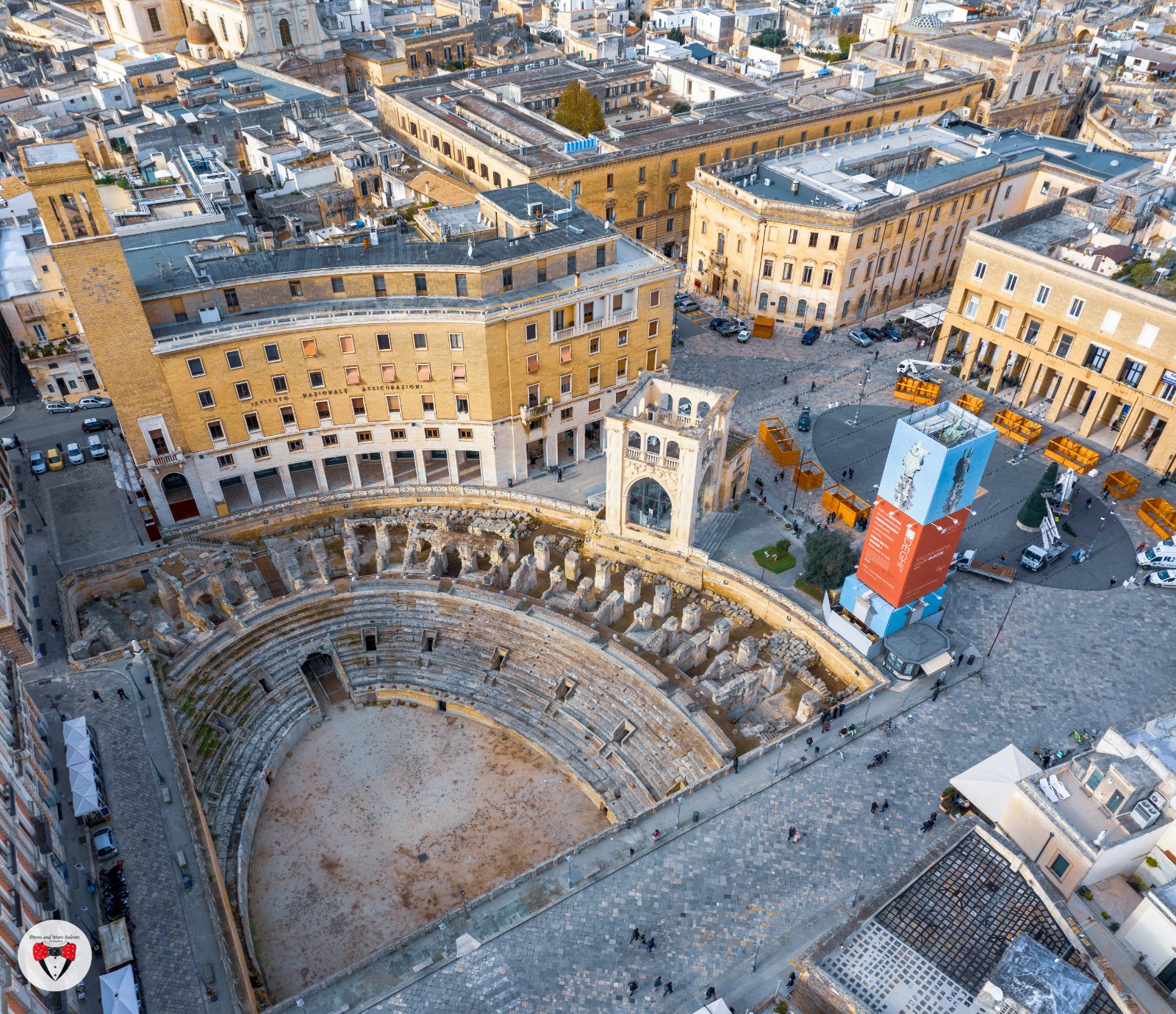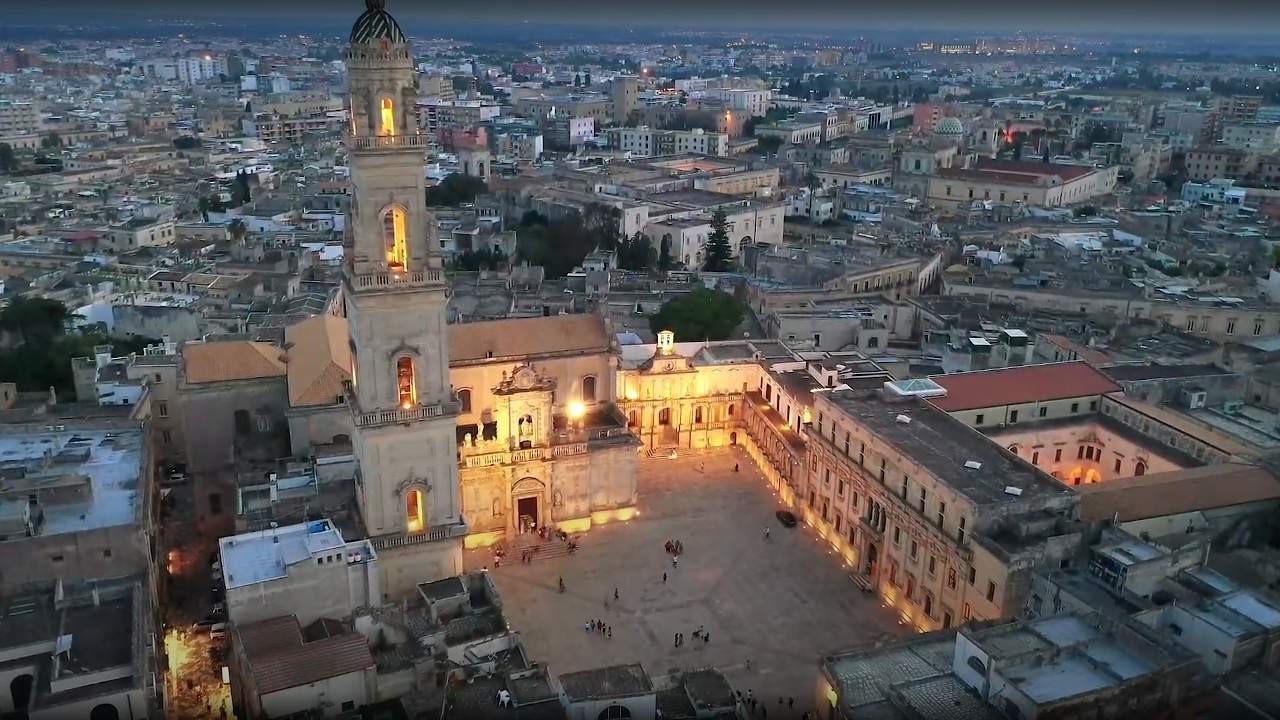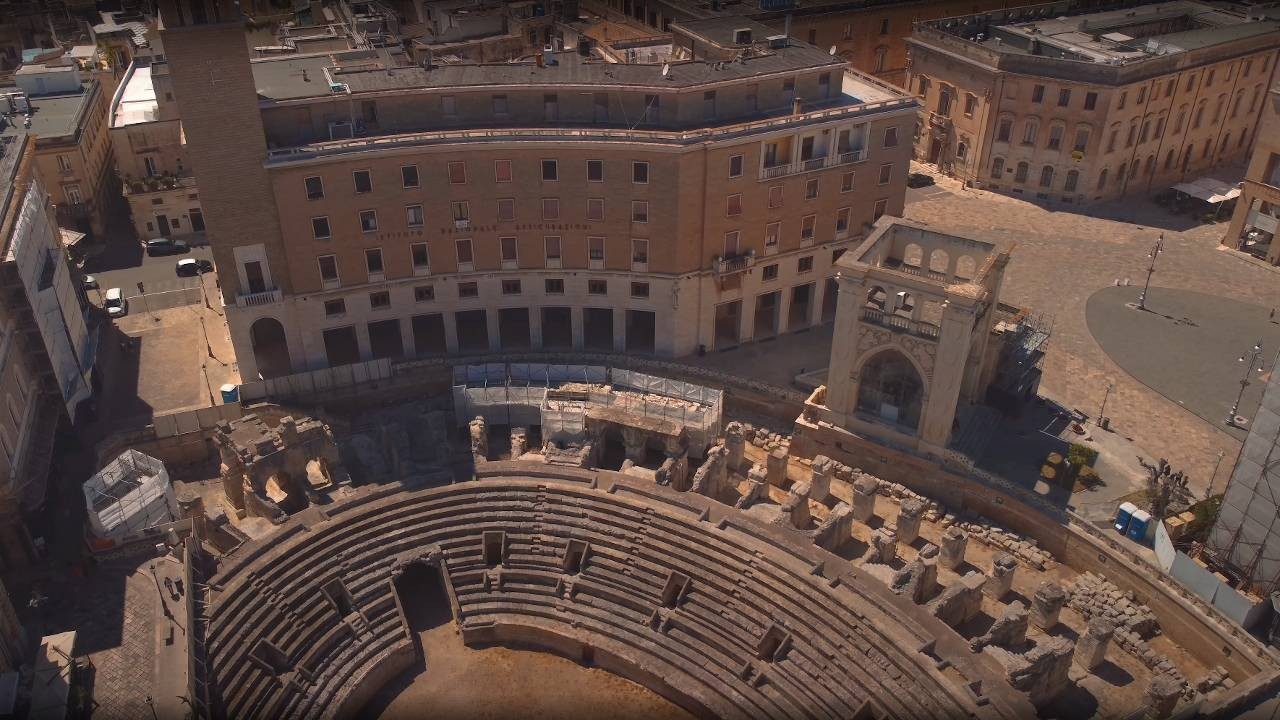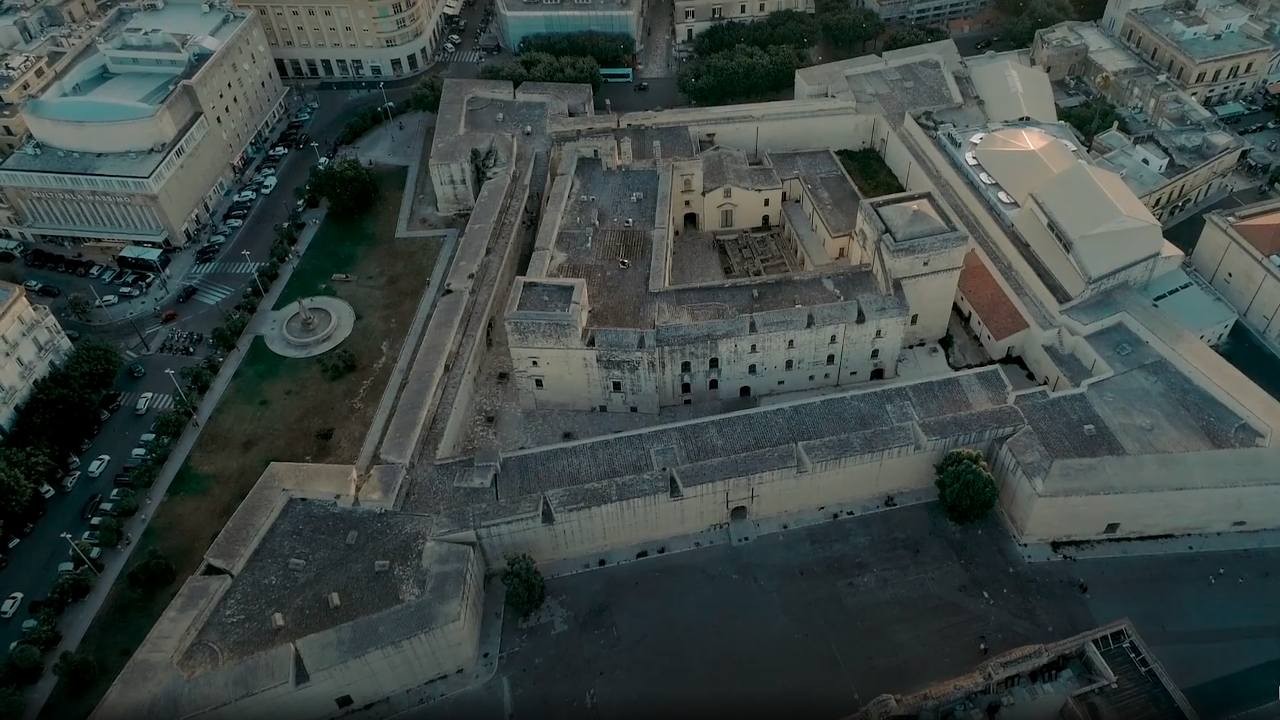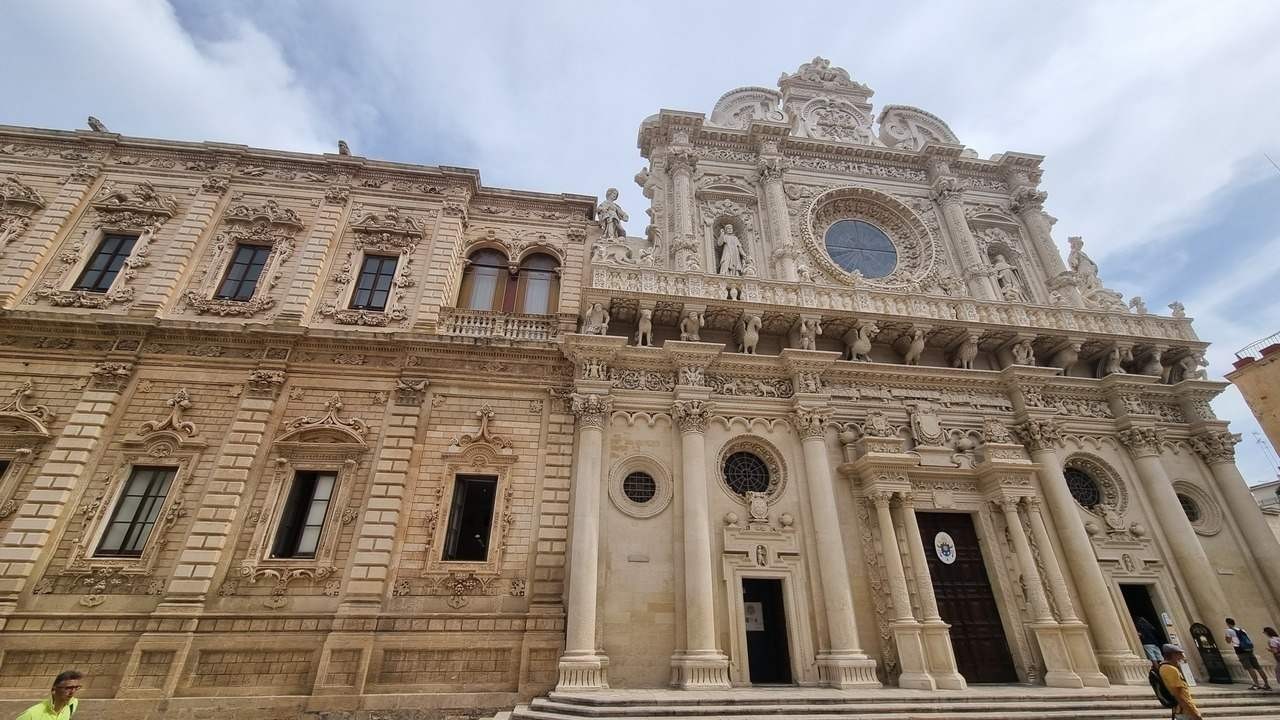Lecce is the beautiful Baroque city capital of the province of Salento, the southernmost area of Puglia also known as the "heel of Italy".
The city of Lecce is at the same time also the easternmost city of Italy and, unlike many important Apulian cities that extend along the coast, it is located inland in a privileged position halfway between the Adriatic Sea and the Sea Ionian.
Lecce is among the oldest cities in Italy and among the best preserved in their beauty and historicity. It was formed by the Messapi people (which from ancient Greek means "land between the two seas"), a population of Greek and Cretan origins, who settled in Salento in 3300 BC and began the transition from settlements of huts into real city from the 9th century BC. The ancient Messapian origins and the Roman domination starting from 260 BC. insert Lecce among the cities of art in Italy and among the most visited places in Puglia.
The city has around 100,000 inhabitants and offers all the services you may need to fully enjoy all the things to see and do during your stay.
Lecce has 6 seaside resorts to choose from, literally, based on how the wind blows.
You can easily alternate the day or evening visits of the city with trips to the beaches even for a few hours and appreciate the best of both.
In fact, you can choose the most suitable seaside resort for the day based on the weather conditions on the coast to enjoy the best days to stay on the beach and enjoy your desired relaxation and fun.
Many visitors decide to stay in Lecce or in the surrounding countryside to fully experience the carefree life of the Apulian hinterland and fully enjoy the great cultural and gastronomic offer of the city, then moving to the sea in a few minutes to spend a few hours by the sea. Lecce is in fact only 10 km from the Adriatic Sea and 30 km from the Ionian Sea and this allows you to travel to a different coast every day. In fact, it is the custom of many to visit different beaches and places of the sea every day and with great ease.
What to do in Lecce
For some years now Lecce has established itself as a summer destination only for its marvelous coasts, but also as a city to visit and in which to spend a few days in order to visit all the things it has to offer.
The many archaeological sites, which recall the Roman domination and the ancient Messapian origins, place Lecce among the most beautiful art cities in Italy ever.
Lecce is therefore above all a city rich in testimonies of the Roman domination, but it is equally rich in testimonies and works of the medieval and Renaissance period.
Lecce stands out for the great diffusion of seventeenth-century Baroque style among the palaces and churches of the center, almost all built with the limestone of the Lecce area which was easily workable by the stonecutters of the time and which gives you wonderful views and works of art. open sky.
In fact it is known for the Lecce Baroque style which took the name of the city for the architecture and enrichment of the buildings typical of this area.
The Lecce Baroque had a period of great development especially under the Bourbon domination of the Kingdom of Naples and the city has managed to preserve all these fantastic works of art in the open to the present day.
If you are on holiday in Puglia and you want to visit Lecce, the things to see are:
- Duomo
- Sant'Oronzo square
- Roman amphitheater
- Basilica of Santa Croce
- Castle of Charles V
- The churches
Lecce Cathedral
In the center of the city is the Duomo, the main church of Lecce which is also known as the Metropolitan Cathedral of Santa Maria Assunta.
Historically, the Cathedral is the nucleus of Lecce's religious life.
The thing that strikes the visitor most, and the first thing one notices upon entering Piazza del Duomo, is its extremely elaborate Baroque facade.
The Cathedral was initially built in 1144 in the Romanesque style but in 1659 it was rebuilt, without altering the original Romanesque plan, in the Lecce Baroque style.
The structure has two different entrances: the main one overlooking the bishop's palace and the secondary one overlooking the square.
The main facade is more sober and rich in statues of saints, the secondary facade is much more sumptuous, built according to the canons of the Lecce Baroque and also adorned with various statues of saints.
The interior of the Cathedral preserves numerous works of art of considerable value, precious marble floors and twelve altars, including the main one in marble and gilded bronze of Neapolitan manufacture.
Sant'Oronzo square in Lecce
Piazza Sant’Oronzo is the central square in Lecce, with an oval shape and a pavement adorned with a gigantic mosaic representing the city's coat of arms.
The buildings surrounding the square are mostly from the Middle Ages and the Renaissance, the result of constructions that have occurred in different eras but which blend harmoniously.
In the past it was known as Piazza dei Mercanti for the large number of artisan shops and commercial activities present.
The square took the name of the patron saint of the city in 1656, when a statue in honor of the saint was installed.
In fact, it is said that the city was spared from the bubonic plague that struck the Kingdom of Naples in those centuries, of which Lecce was a part, thanks to the prayers of the then bishop of the city.
As a sign of thanks, the citizens had the votive column erected, on which a statue in honor of the saint was also installed.
It was Mauro Ranieri who created the statue of Sant’Oronzo in Venice, which today is located in the center of the square.
The square also houses the Roman amphitheater, visible in all its splendor, the ancient church of San Marco (built by citizens of Venetian origin who settled in Lecce in past centuries) and the church of Santa Maria della Grazia.
Roman Amphitheater and the Roman Theater of Lecce
Lecce is the only city to have two Roman amphitheaters in its territory, one in the center and one just outside the city.
The central amphitheater was buried in rubble over the past centuries, due to earthquakes and devastation.
In the early 1900s, archaeological excavations were carried out in Piazza Sant’Oronzo to bring the ancient Roman finds back to luche.
Following the excavations, a part of the Roman Amphitheater has been unearthed (only one third has been brought to light) which today can be observed in the center of the square in all its ancient splendor.
The amphitheater constitutes an important testimony of the Roman domination of the area and of the artistic and cultural ferment already present in Lecce at the time.
Not far from the amphitheater, about 300 meters, there is the other great Roman opera in the center of Lecce, the great Roman Theater with about 5000 spectators.
The Roman Theater, from the same period as the amphitheater, was brought to light for houses in 1929 and was discovered by chance during the works in two buildings adjacent to the amphitheater.
Castle of Charles V in Lecce
A short distance from Piazza Sant'Oronzo stands the castle built by King Charles V in 1539.
The castle took the place of the Chapel of the Holy Trinity and the Celestine Monastery of Santa Croce, from which two of the fortress towers took their name.
For some time the fortification carried out defensive functions of the city until it became, in very recent times, with the passage of time: seat of theatrical performances, barracks and military district.
Today the castle is owned by the municipality of Lecce and is the seat of the Department of Culture. As a result, its spaces are now home to cultural events, artistic exhibitions and events to promote the Lecce area.
Basilica of Santa Croce
The Basilica of Santa Croce is considered the symbol of the Lecce Baroque style.
Between the sixteenth and seventeenth centuries the structure was expertly designed and worked by master stonemasons to make it a monument of spectacular beauty.
One must be amazed by the incredible number of Renaissance elements and the refined Baroque elements, which harmoniously give life to the monument.
The structure fascinates above all for the presence of an imposing central rose window of Romanesque inspiration, finely surrounded by beautiful perfectly preserved sculptures.
You will be entranced by the cultural and artistic ferment of the city of Lecce.
Visiting the city we will be impressed by the care with which citizens and institutions respect and enhance their heritage.
You will be amazed by the quality of the works of art and architectural structures perfectly preserved over time and loved by citizens.
The Churches of Lecce
Lecce was defined in the past as the city of churches due to the presence of 40 sacred buildings, from different historical periods, distributed throughout the city.
Among the oldest there is the Church of Saints Nicolò and Cataldo in the city cemetery built in medieval times and renovated in 700, thus becoming a structure that contains elements of the original style acquiring a strong Baroque imprint.
Among the most original, always from the Baroque period, the Church of San Matteo should be mentioned for its curvilinear shape.
What to see in the province of Lecce
Lecce is an artistic and cultural jewel but the province is no exception.
Also in the province of Lecce you can enjoy what once were the possessions of the city: the countryside, the wild nature and the wonderful coasts.
The marina of Lecce was also enriched by the presence of seaports, both on the Adriatic Sea and on the Ionian Sea, which made the city great thanks to fishing activities and above all to commercial activities with peoples from all over the Mediterranean.
The cities on the sea are in turn artistic and architectural jewels, unique of their kind and perfectly preserved, which offer tourists cultural moments of the highest level accompanied by moments of relaxation and pleasure to be spent on the beautiful beaches nearby.
What are the best places near Lecce with the most beautiful beaches?
The 5 places on the sea near Lecce with the most beautiful beaches are:
- Otranto
- Gallipoli
- Porto Cesareo
- Santa Maria di Leuca
- Marina di Pescoluse
Otranto
Otranto is an ancient fortified port city in the province of Lecce.
It is located on the Adriatic coast of Puglia at the easternmost point of Italy
According to nautical rules it is in a point that seems to divide the Adriatic Sea from the Ionian Sea.
The coast of Otranto extends for 25 kilometers.
The marina of Otranto is characterized by wonderful beaches, much loved by visitors, sometimes rocky with wonderful cliffs overlooking the sea.
Brief history of the city of Otranto
During the dominion of the Roman Empire, the city was known as Hydruntum, referring to the small stream called Idro, which stretches within the municipal area and flows into the port.
At the time of the Romans, Otranto was considered a strategic seafaring city for moving to the east and the importance of its port made it, during the Middle Ages, the main city of passage between East and West.
A tragic event that marks the city, and which marks the citizens forever, was the invasion suffered in 1480 when the Turks of Mohammed II massacred the population after attacking and conquering the city.
About 800 citizens of Otranto were brutally killed for not having denied the Christian cult: today we know these men as the Martyrs of Otranto.
The relics of the Martyrs of Otranto are today found in the Cathedral of Otranto, Lecce which has thus become the symbol of Christianity in Salento.
After this first Ottoman attack the city fortified itself, building walls and bastions near the sea and the port, creating the Aragonese Castle.
Through the Castle the citizens of Otranto managed to resist further attacks by the Turks in the following years.
Today you can visit these places and admire the walls, and the surrounding buildings, restored to their former glory.
With the passage of time Otranto lost its commercial importance and consequently the population, no longer withstanding the continuous attacks by sea by the Turks and marauders of other nationalities, began to move to safer places in the hinterland.
Over the centuries the city of Otranto was able to recover economically and the citizens were able to start various reclamation works of the surrounding marshes.
An example of this is the area surrounding the Alimini Lakes, which was reclaimed in the 19th century and which today constitute one of the most beautiful and precious natural landscapes in Puglia.
Gallipoli
Gallipoli is divided between the historic center and the new village.
The historic center was born on an island that connects to the new village via a brick bridge.
Walking through the historic center, you can discover the ancient streets, churches and palaces, which, like the city of Lecce, are characterized by a baroque style.
The beaches of Gallipoli are among the most popular Apulian beaches.
These are easily accessible from the city center; you can easily choose one of the various sandy beaches that follow one another.
Porto Cesareo
Porto Cesareo is one of the most popular Apulian locations for its splendid coast with crystal clear waters.
The coast of this locality is divided into two coasts, that of the east and that of the west.
The first includes the town beach; while the second is characterized by many bathing establishments with low and sandy beaches that alternate with cliffs.
Torre Lapillo beach is one of the most popular. Like the whole coast, this beach is also characterized by a transparent and crystalline sea.
The beach is dominated by an ancient coastal tower, identifiable in the inlet called "dead man", on a rocky point.
You can visit the tower and from its roof you can enjoy a beautiful view of the surrounding area.
If you are looking for crystal clear waters and a beach of fine white sand then the Punta Prosciutto beach is one of the most suitable places for you.
Santa Maria di Leuca
Further south of the province of Lecce is Santa Maria di Leuca.
Consisting of a higher area where the Basilica and the Lighthouse are located and a second lower area connected to the first by a staircase.
The town is one of the most visited in Puglia, an important attraction for tourists who are fascinated by the Salento coast.
The whole coast is characterized by the presence of caves, which can be visited thanks to organized boat tours.
Marina di Pescoluse
Marina di Pescoluse is located near Santa Maria di Leuca, at the very edge of Puglia, at the point where the Adriatic and Ionian Seas meet.
The town is very close to the beaches.
The coast of Pescoluse is known as the Maldives of Salento.
Its beach is in fact one of the most beautiful beaches in Puglia, with very fine white sand, shallow waters and crystal clear waters.
